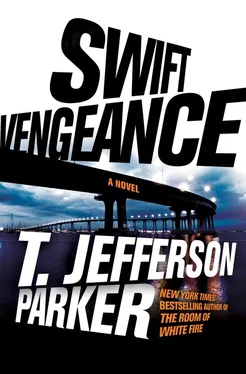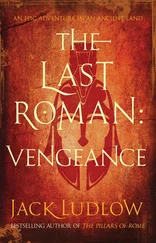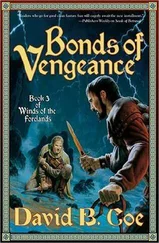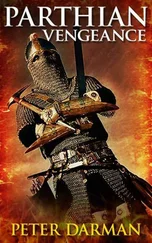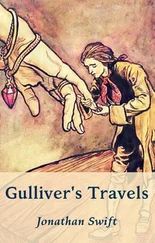“Bravo regazzo,” said Lindsey, gently. “Good boy.”
He sat very still and never took his eyes off Rose as she rolled up the window and Bruno backed up the truck and drove away.
Late that blustery afternoon, I sat in my truck across the street and a few doors down from Hector Padilla’s home. I had a hunch and time to bet on it.
It was Friday and this El Cajon hood had a bustling, home-from-work feel. Christmas lights were up and some already turned on. A minivan pulled into the driveway next door to Hector’s. The garage door went up. A woman unleashed two young children, who spilled past her through the sliding door. All three gathered at the rear of the vehicle. The lift gate opened and they wrestled out a tightly wrapped noble fir, which they lugged into the garage. The girl had on pink rubber boots and a pink fur-lined coat, and the boy wore floppy black board shoes and a silver quilted parka. I pay attention to children because Justine did. We wanted one. For starters. We had happily set ourselves to the task of creating one, just hours before she took off in Hall Pass that final day.
My slick, fold-out invitation to opening night of the “Treasures of Araby” exhibition and sale — a gift from Padilla to Imam Hadi Yousef, then from Yousef to me — lay on the passenger seat.
GALLERIE MONFIL PRESENTS
The Treasures of Araby
Collectible Art, Artifacts, and Antiques
From Exotic West Asia
The opening-night party, to which the bearer of this invitation was welcome, was set to begin in two hours, at six p.m. in Solana Beach.
I took my time reading the invite copy and looking at the pictures again. I braced it on the steering wheel so I could read and still see activity at Hector’s house. The booklet opened into four panels on each side, for a total of eight pages. Two panels were dedicated to each of four exhibits:
OF CARPETS & MAGIC
CENTURIES IN TILE AND TEXTILE
ART, SENSE, AND SPIRIT
THE SWORDS OF ARABY
The pictured carpets for “Of Carpets & Magic” made me think of the collection of Persian rugs that had come with the house I live in. The carpets had been collected over the years by the various Timmerman family occupants of Rancho de los Robles, many of whom took their carpets seriously. Some of the invitation pictures looked very much like the rugs I unmagically traipsed over daily.
The pictured tiles were intricate and beautiful, most of them Arabesque variations of flowers, plants, and animals. The elegant calligraphic script reminded me of Caliphornia’s handwritten correspondence.
The image for “Art, Sense, and Spirit” was a reprinted sixteenth-century Iraqi painting titled Prince Conversing with a Mythical Bird . It was done pre-perspective, making it oddly flat and swirling.
“The Swords of Araby” pictured an Arabic saif sword, curved in deadly grace, handle and hilt intricately engraved with calligraphic script and songbirds. I thought of Kenny Bryce and the threat letters to the Headhunters. How could I not? Something alien and cold stirred inside me.
I looked up from the sword to Hector Padilla’s quaint El Cajon home. I imagined his Qur’an, his energy drinks, these invitations, and the large sharpening stone spilling from his upturned backpack to Hadi’s desk. I thought of Taucher’s cogent question: Who carries around a sharpening stone? A seemingly hapless hospital janitor who wants to become a Muslim and learn Arabic in order to find a Muslim woman?
At five sharp, Hector’s garage door rose and the shiny black Cube backed out into the mid-December dark. I fell in behind it. Hector drove as he had driven before, exactly the speed limit, signaling turns well ahead of time, waiting at least three full seconds at each stop sign. He picked up Interstate 8 west to the 5 north, headed for Solana Beach. I was pretty sure where he was going. Nice work, Ford. I stayed two cars behind in the heavy traffic. Predictably, Hector drove only in the slower, second-from-the-outside lane. The Cube, freshly washed and waxed, gleamed in the lights of the exit signs.
Hector exited Via de la Valle, loafed his way to South Cedros Avenue, and turned right. Cedros Avenue was an upscale retail zone: galleries, furniture, lifestyle purveyors, the Belly Up nightclub, where I had spent a number of nights with Justine — and, later, without her. Hector circled the crowded area patiently, finally finding a place. I parallel-parked half a block down, keeping an eye on him.
Not difficult. By the time he had gotten out of his car and made it to the parking meter, which seemed to be puzzling him, I had paid and caught up. I’d never really seen him before, except pictured on Taucher’s wall or sitting in his car. He appeared less than average in height. Bushy dark hair and a small pot belly. Jeans too small and Raiders hoodie too big.
I window-shopped a contemporary art gallery, fingering the GPS tracker in my coat pocket. Nifty gadget: reports the host vehicle’s location to your phone every second while in motion, so you can become invisible. It never needs a line of sight. Gives you time/date/address for every stop, sleeps when your target isn’t moving, waterproof, with a built-in magnetic fastener strong enough to keep it secure on a car chassis. Fifty hours of charge, one hundred ninety-nine bucks.
I’d had a good long look at the paintings in the window by the time Hector solved the meter, locked up his Cube, and headed down Cedros, tapping what looked like a rolled-up magazine against one leg. I gave him a good lead, then followed, kneeling to activate the GPS tracker and attach it to the rear chassis of the Cube. It jumped to the metal frame with a heavy clunk.
The Gallerie Monfil was a big corner building, a three-level gallery/warehouse I’d visited several times. They specialize in folk and primitive art and crafts from around the world, handmade furniture, ceramics, weaving, textiles, carvings, vessels, and jewelry.
Hector walked toward the entrance. Well-dressed people bustled in around him, winter finery finally on display in sunny San Diego County, and I was surprised by how many visitors there were. Hector stood in the line, the invitation protruding from his magazine, which he leafed through as he waited. He paused and checked his phone, then looked at the people around him, a half-smile on his face. I held back, watched a woman in a green dress stride by, diamonds in her ears, a faux-mink stole on her neck, a man with a phone in tow. She looked at me unhurriedly. A calligraphic sign announced The Treasures of Araby — Level Three. Docent-guided tours at 7 and 9 p.m.
I drifted into the building a minute or two after Hector. Claimed a free glass of champagne off a table in the lobby. Heard the holiday music coming from the PA. Then climbed the wide maple-and-stainless-steel stairs to level three.
I entered a spacious rotunda buzzing with visitors. Dramatically elevated in the center was a life-size bronze Arabian charger with a warrior astride it, scimitar lifted high. The sculptor had captured speed and balance. Around this centerpiece stood lesser statues, metal sculptures and wooden carvings and large, free-standing ceramic vessels. From amid these rose tapestries and fine fabric pavilions and lilting silk banners, and the walls were hung with carpets. Each object had an orange price tag on it. Beyond all this I saw that four salons branched off in four directions, spokes from a hub, each bannered overhead with the names of the collection’s four exhibits.
Читать дальше
